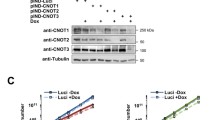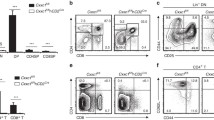Abstract
The zinc finger X-linked duplicated A (ZXDA) and ZXDC proteins are both required for robust transcription of major histocompatibility complex class II (MHC II) genes. Aside from the full length ZXDC mRNA transcript, at least one additional mRNA is produced by the ZXDC gene, in which transcription initiates within the first exon and terminates within the seventh intron. The protein product produced from this transcript, which we have named ZXDC2, is truncated on both the N- and C-terminus. We demonstrate here that ZXDC2 functions to repress MHC II transcription induced in HeLa cells treated with IFN-γ. We further demonstrate that ZXDC2 interacts with both ZXDA and ZXDC, suggesting a mechanism by which ZXDC2 may inhibit MHC II transcription. These studies not only provide additional support for the role of ZXD proteins in regulating MHC II transcription, but also demonstrate a unique mechanism for the synthesis of a mRNA isoform.




Similar content being viewed by others
References
Boss JM, Jensen PE (2003) Transcriptional regulation of the MHC class II antigen presentation pathway. Curr Opin Immunol 15:105–111
Nekrep N, Fontes JD, Geyer M, Peterlin BM (2003) When the lymphocyte loses its clothes. Immunity 18:453–457
Villard J, Lisowska-Grospierre B, van den Elsen P, Fischer A, Reith W, Mach B (1997) Mutation of RFXAP, a regulator of MHC class II genes, in primary MHC class II deficiency. N Engl J Med 337:748–753
Steimle V, Durand B, Barras E, Zufferey M, Hadam MR, Mach B, Reith W (1995) A novel DNA-binding regulatory factor is mutated in primary MHC class II deficiency (bare lymphocyte syndrome). Genes Dev 9:1021–1032
Masternak K, Barras E, Zufferey M, Conrad B, Corthals G, Aebersold R, Sanchez JC, Hochstrasser DF, Mach B, Reith W (1998) A gene encoding a novel RFX-associated transactivator is mutated in the majority of MHC class II deficiency patients. Nat Genet 20:273–277
Nagarajan UM, Louis-Plence P, DeSandro A, Nilsen R, Bushey A, Boss JM (1999) RFX-B is the gene responsible for the most common cause of the bare lymphocyte syndrome, an MHC class II immunodeficiency. Immunity 10:153–162
Moreno CS, Beresford GW, Louis-Plence P, Morris AC, Boss JM (1999) CREB regulates MHC class II expression in a CIITA-dependent manner. Immunity 10:143–151
Kretsovali A, Agalioti T, Spilianakis C, Tzortzakaki E, Merika M, Papamatheakis J (1998) Involvement of CREB binding protein in expression of major histocompatibility complex class II genes via interaction with the class II transactivator. Mol Cell Biol 18:6777–6783
Hooft van Huijsduijnen R, Li XY, Black D, Matthes H, Benoist C, Mathis D (1990) Co-evolution from yeast to mouse: cDNA cloning of the two NF-Y (CP-1/CBF) subunits. Embo J 9:3119–3127
Mantovani R, Pessara U, Tronche F, Li XY, Knapp AM, Pasquali JL, Benoist C, Mathis D (1992) Monoclonal antibodies to NF-Y define its function in MHC class II and albumin gene transcription. Embo J 11:3315–3322
Steimle V, Otten LA, Zufferey M, Mach B (1993) Complementation cloning of an MHC class II transactivator mutated in hereditary MHC class II deficiency (or bare lymphocyte syndrome). Cell 75:135–146
Wright KL, Ting JP (2006) Epigenetic regulation of MHC-II and CIITA genes. Trends Immunol 27:405–412
Al-Kandari W, Jambunathan S, Navalgund V, Koneni R, Freer M, Parimi N, Mudhasani R, Fontes JD (2007) ZXDC, a novel zinc finger protein that binds CIITA and activates MHC gene transcription. Mol Immunol 44:311–321
Greig GM, Sharp CB, Carrel L, Willard HF (1993) Duplicated zinc finger protein genes on the proximal short arm of the human X chromosome: isolation, characterization and X-inactivation studies. Hum Mol Genet 2:1611–1618
Al-Kandari W, Koneni R, Navalgund V, Aleksandrova A, Jambunathan S, Fontes JD (2007) The zinc finger proteins ZXDA and ZXDC form a complex that binds CIITA and regulates MHC II gene transcription. J Mol Biol 369:1175–1187
Accolla RS (1983) Human B cell variants immunoselected against a single Ia antigen subset have lost expression of several Ia antigen subsets. J Exp Med 157:1053–1058
Mudhasani R, Fontes JD (2002) The class II transactivator requires brahma-related gene 1 to activate transcription of major histocompatibility complex class II genes. Mol Cell Biol 22:5019–5026
Kent WJ (2002) BLAT–the BLAST-like alignment tool. Genome Res 12:656–664
Sandelin A, Carninci P, Lenhard B, Ponjavic J, Hayashizaki Y, Hume DA (2007) Mammalian RNA polymerase II core promoters: insights from genome-wide studies. Nat Rev Genet 8:424–436
Wakaguri H, Yamashita R, Suzuki Y, Sugano S, Nakai K (2008) DBTSS: database of transcription start sites, progress report 2008. Nucleic Acids Res 36:D97–D101
Jambunathan S, Fontes JD (2007) Sumoylation of the zinc finger protein ZXDC enhances the function of its transcriptional activation domain. Biol Chem 388:965–972
Carninci P, Sandelin A, Lenhard B, Katayama S, Shimokawa K, Ponjavic J, Semple CA, Taylor MS, Engstrom PG, Frith MC, Forrest AR, Alkema WB, Tan SL, Plessy C, Kodzius R, Ravasi T, Kasukawa T, Fukuda S, Kanamori-Katayama M, Kitazume Y, Kawaji H, Kai C, Nakamura M, Konno H, Nakano K, Mottagui-Tabar S, Arner P, Chesi A, Gustincich S, Persichetti F, Suzuki H, Grimmond SM, Wells CA, Orlando V, Wahlestedt C, Liu ET, Harbers M, Kawai J, Bajic VB, Hume DA, Hayashizaki Y (2006) Genome-wide analysis of mammalian promoter architecture and evolution. Nat Genet 38:626–635
Hirose Y, Manley JL (2000) RNA polymerase II and the integration of nuclear events. Genes Dev 14:1415–1429
Neugebauer KM (2002) On the importance of being co-transcriptional. J Cell Sci 115:3865–3871
Proudfoot NJ, Furger A, Dye MJ (2002) Integrating mRNA processing with transcription. Cell 108:501–512
Egloff S, Murphy S (2008) Cracking the RNA polymerase II CTD code. Trends Genet 24:280–288
Author information
Authors and Affiliations
Corresponding author
Rights and permissions
About this article
Cite this article
Aleksandrova, A., Galkin, O., Koneni, R. et al. An N- and C-terminal truncated isoform of zinc finger X-linked duplicated C protein represses MHC class II transcription. Mol Cell Biochem 337, 1–7 (2010). https://doi.org/10.1007/s11010-009-0280-5
Received:
Accepted:
Published:
Issue Date:
DOI: https://doi.org/10.1007/s11010-009-0280-5




